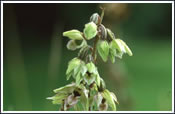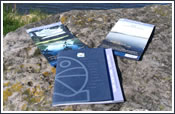
Wildlife Along the Aqueduct
Although the canal aqueduct is primarily an historic item it is also important as an area that is looked after for its wildlife interest as well. The fact that it passes through two nature reserves indicates the kind of value there is in the area. Although the reserves are based on the culm grassland habitat of which there is none on the narrow line of the Trust’s ownership, much of the wildlife associated with it may be seen along the tow-path.
 At present time there is not much open water but where there is, frog spawn and dragonflies are to be found. One interesting plant of the wetter open sections is Marsh Cinquefoil. Kingcups (Marsh Marigold) are quite frequent along the whole length. The large clumps of Tussock Sedge give a wilderness feel to some stretches.
At present time there is not much open water but where there is, frog spawn and dragonflies are to be found. One interesting plant of the wetter open sections is Marsh Cinquefoil. Kingcups (Marsh Marigold) are quite frequent along the whole length. The large clumps of Tussock Sedge give a wilderness feel to some stretches.
Most of the path is bounded by willow and blackthorn. In this rather overgrown habitat you can hear the waterfall song of Willow Warblers or the bubbling song of Blackcaps in spring. Other sections of the path pass between mature woods and here there may be Chiffchaffs, Wrens, and Blackbirds.
 Flowers along the path-side begin in February when there are snowdrops near Dexbeer. It isn’t long before Primroses and then Bluebells and Queen Anne’s Lace line the sides of the path. With summer comes the tall Purple Loosestrife. Of special importance at this time are the occasional Broad-leaved Helleborine, particularly along the stretch from Puckland Bridge to the old Vealand waterworks site.
Flowers along the path-side begin in February when there are snowdrops near Dexbeer. It isn’t long before Primroses and then Bluebells and Queen Anne’s Lace line the sides of the path. With summer comes the tall Purple Loosestrife. Of special importance at this time are the occasional Broad-leaved Helleborine, particularly along the stretch from Puckland Bridge to the old Vealand waterworks site.
Butterflies are numerous, especially Speckled Wood, Green-veined White, and in summer, the magnificent Silver-washed Fritillary. Unfortunately the nationally scarce Marsh Fritillary doesn’t stray off the reserves but it is worth popping onto the reserves to try to see them in early June.
 Evidence of Dormouse has been found at various locations but they only come out at night. However, do look out for Hazel nuts that have been opened by them, or even one of their grass nests hidden among the brambles. Otters almost certainly use the line of the canal, and there is clear evidence of them at Lower Tamar Lake.
Evidence of Dormouse has been found at various locations but they only come out at night. However, do look out for Hazel nuts that have been opened by them, or even one of their grass nests hidden among the brambles. Otters almost certainly use the line of the canal, and there is clear evidence of them at Lower Tamar Lake.
One of the rarest things to be found along the aqueduct is a fungus! It is a nationally rare one called Hazel Gloves and grows on dead Hazel branches.
All these things mean that we have to be careful how we manage the vegetation. We do try to balance the access with the historic interest and the wildlife habitat.
Wildlife & Landscape

